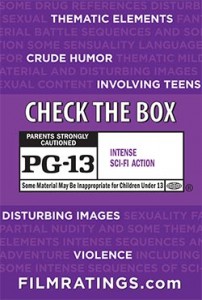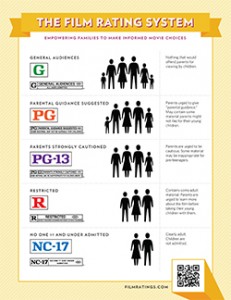Forty Years of Movie Ratings
For over forty years the movie rating system has served to provide America’s parents with the information necessary to make informed and responsible decisions about their kids’ movie going choices. NATO cofounded the system with the Motion Picture Association. Over the four decades, our members have turned away millions of dollars in business to enforce the ratings, and we continue to work on improvements. Over the years, NATO members have adopted and implemented a 12-point initiative on ratings education and enforcement, and NATO has distributed materials and training tapes to our members to assist them in their enforcement efforts.
The rating system is a shared responsibility between the entertainment industry and America’s parents. Advertisements for movies with adult content should not be targeted to children. NATO believes that parents must be informed in order to make responsible decisions.
Movie Ratings Guide
Would you like to learn more about the Rating System, such as what type of content fits into the different rating categories, the criteria for raters, and the appeal process? Click here for the Rating Rules.
Want to know more about how the over 60,000 pieces of movie advertising submitted annually? Click here for the Advertising Rules, which include how advertisements are reviewed and approved to play with compatible programming, and the rating information they provide.
What is the purpose of the rating system? Movie ratings provide parents with advance information about the content of movies to help them determine what movies are appropriate for their children at any age. After all, parents are best suited to knowing each of their children’s individual sensitivities and sensibilities to pick movies for them. Ratings are assigned by a board of parents who consider factors such as violence, sex, language and drug use, then assign a rating they believe the majority of American parents would give a movie.
Do ratings indicate if a movie is good or bad? No. Audiences and film critics make these determinations. The ratings are not intended to approve, disapprove or censor any movie. Rather, ratings offer guidance to parents regarding the level of content in a movie.
Do all movies have to be rated? No. Submitting a movie for a rating is a voluntary decision made by filmmakers. However, the overwhelming majority of filmmakers have their movies rated, and each member of the Motion Picture Association of America has agreed to have all its theatrically released movies rated.
What about movie advertising in theaters? In conjunction with CARA’s process of reviewing and rating movies, MPAA the takes every step possible to ensure that all advertising content is suitable for the particular audience that views it. They review more than 60,000 pieces of marketing each year, including theatrical, home video and online trailers, print ads, radio and TV spots, press kits, billboards, bus shelters, posters and other promotional materials. Their goal is to give parents the same confidence in movie advertising that they have in the movie rating system, while also allowing filmmakers to responsibly market their movies to their intended audiences.
The key to movie advertising is compatibility. With trailers, the MPAA Advertising Administration considers many factors to ensure their compatibility with the feature; on TV, they consider compatibility to the programming. Ultimately, MPAA strives to make sure that if parents are comfortable with the content of the feature, TV programming or other media, then they will be comfortable with the trailers or other ads that go with them.


